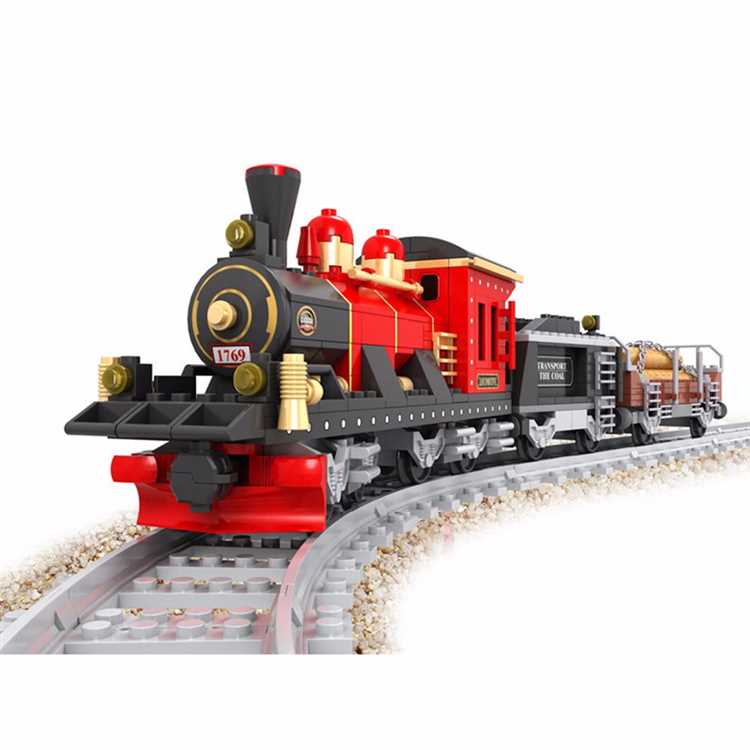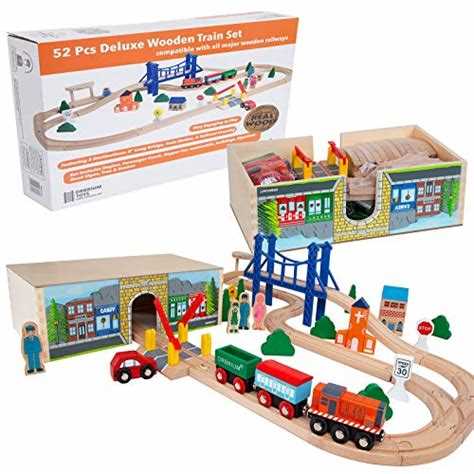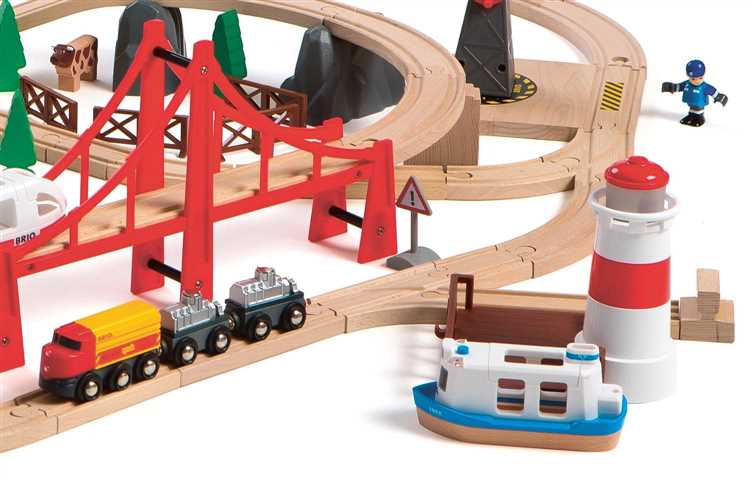Toy trains have been a cherished plaything for children for generations. There is something magical about the clickety-clack of the wheels on the tracks and the chugging sound of the locomotive. Wooden toy trains, in particular, have a timeless appeal that has captivated children and adults alike.
Building wooden toy trains is not only a fun hobby but also a way to create classic playthings for children. These toys not only provide endless hours of entertainment but also promote creativity, imagination, and problem-solving skills. By building wooden toy trains, children can learn about engineering and construction while having fun.
Wooden toy trains come in a variety of styles and designs. From steam engines to diesel locomotives, there are endless possibilities for customization. Children can choose their favorite colors, add their own decals, and even build their own train tracks. Wooden toy trains can be a blank canvas for children to express their creativity.
Moreover, wooden toy trains offer a nostalgic charm that modern plastic toys lack. These timeless playthings evoke memories of a simpler time when imagination and creativity were paramount. They are not just toys; they are cherished heirlooms that can be passed down from generation to generation, creating lasting memories for families.
So, whether you are a hobbyist looking to build wooden toy trains or a parent searching for a classic plaything for your child, consider the timeless appeal of wooden toy trains. With their endless possibilities for customization and their ability to promote creativity and imagination, wooden toy trains are sure to delight children of all ages.
History of Wooden Toy Trains
Wooden toy trains have a long and fascinating history that dates back to the early 19th century. These timeless playthings have captivated the imagination of children for generations and continue to be cherished today.
The origins of wooden toy trains can be traced back to Germany in the mid-1800s. It was during this time that the first wooden train sets were produced, featuring hand-carved wooden tracks and trains. These early trains were simple and often resembled real steam locomotives of the era.
Wooden toy trains gained popularity throughout Europe in the late 19th century, with companies like Märklin leading the way in manufacturing these delightful toys. Märklin, founded in 1859, is credited with creating the first standardized track system for wooden toy trains, allowing for interchangeable parts and expansion of train layouts.
In the early 20th century, wooden toy trains made their way to the United States and quickly became a beloved playtime activity. Companies like Lionel and American Flyer began producing their own versions of wooden toy trains, incorporating innovative features such as electric lights and sound effects.
During World War II, the production of wooden toy trains was halted as resources were redirected towards the war effort. However, after the war, the popularity of wooden toy trains soared once again. Manufacturers like Brio and Thomas & Friends (originally known as Thomas the Tank Engine) introduced wooden trains with vibrant colors and whimsical characters, capturing the hearts of children worldwide.
Today, wooden toy trains continue to be a beloved playtime staple. Their timeless design and durability have made them a favorite among parents and collectors alike. Many modern wooden toy trains incorporate magnetic connectors, allowing for easy assembly and reconfiguration of train sets.
Wooden toy trains have come a long way since their humble beginnings in the 19th century. They have stood the test of time and continue to spark the imagination of children, fostering creativity and imaginative play for generations to come.
Benefits of Wooden Toy Trains for Children
1. Enhances creativity and imaginative play: Wooden toy trains provide children with endless opportunities to create and build their own worlds. They can design their own train tracks, set up scenes, and invent stories, fostering their creativity and imagination.
2. Develops fine motor skills: Playing with wooden toy trains requires children to manipulate the train cars and place them on the tracks. This helps improve their hand-eye coordination and fine motor skills.
3. Encourages problem-solving: When building train tracks, children often come across obstacles or challenges. They need to think critically and problem-solve to overcome these obstacles. This helps develop their problem-solving skills and teaches perseverance.
4. Promotes social interaction: Wooden toy trains are a great way for children to engage in cooperative play. They can work together to build tracks, take turns playing with the trains, and engage in imaginative role-playing. This promotes social interaction and teaches important social skills such as sharing and teamwork.
5. Stimulates cognitive development: Playing with wooden toy trains can help children develop their cognitive skills. They learn about cause and effect as they push the trains along the tracks, understand concepts such as speed and direction, and experiment with different train configurations.
6. Provides a sensory experience: Wooden toy trains have a tactile feel and natural wood scent that can engage a child’s senses. This helps create a multisensory experience and enhances their overall playtime enjoyment.
7. Offers a screen-free alternative: In a world dominated by screens, wooden toy trains offer a screen-free alternative for children to engage in meaningful play. They encourage active play and creativity, without the distractions of electronic devices.
| Enhances creativity and imaginary play | Develops fine motor skills | Encourages problem-solving | Promotes social interaction |
| Stimulates cognitive development | Provides a sensory experience | Offers a screen-free alternative |
Design Elements of Wooden Toy Trains
Wooden toy trains are beloved by children and collectors alike. These classic playthings are not only fun to play with, but they also showcase a variety of design elements that make them visually appealing. Here are some key design features of wooden toy trains:
- Simple shapes: Wooden toy trains typically have simple and recognizable shapes, such as a cylindrical or rectangular body for the train cars, and a triangular or rectangular shape for the engine. These simple shapes make the trains easy to identify and play with.
- Bright colors: Wooden toy trains often feature bright and vibrant colors, like red, blue, green, and yellow. These colors catch the eye and add to the visual appeal of the trains. They also make the trains more attractive to children, who are naturally drawn to bright colors.
- Smooth surfaces: Wooden toy trains have smooth surfaces that are pleasant to touch. The smoothness adds to the tactile enjoyment of playing with the trains, and it also enhances the overall craftsmanship of the toys.
- Artistic details: Many wooden toy trains feature artistic details, such as painted windows, doors, and wheels. These details give the trains a more realistic look and make them visually interesting to look at. They also showcase the craftsmanship and attention to detail that goes into making wooden toy trains.
- Movable parts: Wooden toy trains often have movable parts, like wheels that spin or train cars that can be attached and detached using magnets or hooks. These movable parts add to the playability of the trains and allow children to interact and engage with them in different ways.
In conclusion, the design elements of wooden toy trains contribute to their overall appeal and playability. The simple shapes, bright colors, smooth surfaces, artistic details, and movable parts all come together to create classic playthings that children love and cherish.
Building Techniques for Wooden Toy Trains
Woodworking Basics:
- Start by selecting a high-quality wood such as birch, maple, or oak. These woods are durable and can withstand the wear and tear of playtime.
- Ensure that the wood is smooth and free of splinters by sanding it before beginning any construction.
- Use safety equipment such as goggles and gloves to protect yourself during woodworking tasks.
Cutting and Shaping the Wood:
- Measure and mark the desired lengths for the different parts of the train, such as the body and wheels.
- Use a saw to cut the wood according to the measurements. Be precise to ensure proper fitting of the pieces.
- Use a wood file or sandpaper to shape the edges of the wooden parts, giving them a smooth and rounded finish.
Joining the Pieces:
- Decide on the type of joinery you prefer, such as butt joints or dovetail joints.
- Use wood glue to secure the pieces together, making sure to apply even pressure while the glue sets.
- For added strength, use woodworking clamps to hold the pieces in place while the glue dries.
Adding Details and Features:
- Enhance the toy train’s appearance by adding details such as windows, doors, and smokestacks using smaller pieces of wood.
- Use non-toxic paint or stain to add color and protect the wood from damage.
- Consider incorporating wheels or other moving parts, ensuring they are securely attached for safe play.
Finishing Touches:
- Apply a clear coat or varnish to protect the wood and give the toy train a polished look.
- Ensure all edges are smooth and free of sharp corners to prevent any potential injuries.
- Inspect the final product for any loose parts or weaknesses, making any necessary adjustments before final use.
Conclusion
Building a wooden toy train requires attention to detail, patience, and a love for woodworking. By following these building techniques, you can create a classic plaything that children will cherish for years to come.
Popular Wooden Toy Train Brands
When it comes to wooden toy trains, there are several popular brands that have been delighting children and collectors alike for decades. These brands are known for their quality craftsmanship, attention to detail, and the timeless appeal of their products. Here are a few of the top wooden toy train brands:
- Brio: Brio is one of the most well-known and respected brands in the wooden toy train industry. They have been producing high-quality wooden trains since the 1950s. Brio trains are known for their bright colors, magnetic couplings, and compatibility with other Brio sets.
- Thomas & Friends: Based on the popular TV series, Thomas & Friends offers a wide range of wooden toy trains that feature beloved characters like Thomas, Percy, and James. These trains are made with care and attention to detail, and they are designed to inspire children’s imaginations.
- PlanToys: PlanToys is a brand that is committed to sustainable and eco-friendly practices. Their wooden toy trains are made from rubberwood, a renewable resource, and they use non-toxic dyes and finishes. PlanToys trains are known for their modern designs and innovative features.
- Bigjigs Rail: Bigjigs Rail is a UK-based brand that offers a wide range of wooden toy trains and accessories. Their products are known for their durability and affordability. Bigjigs Rail trains come in a variety of themes, including farm, construction, and safari.
These are just a few examples of the many popular wooden toy train brands available. Each brand brings its own unique style and features to the table, making them suitable for different interests and age groups. Whether you’re looking for a classic set or something more modern, there’s a wooden toy train brand out there for you!
Collecting Wooden Toy Trains: A Hobby for All Ages
Collecting wooden toy trains is a timeless hobby that appeals to both children and adults. These classic playthings not only provide entertainment but also hold a sentimental value for many collectors. Whether you are a passionate train enthusiast or a parent looking to start a collection for your child, wooden toy trains offer a world of wonder and imagination.
The Appeal of Wooden Toy Trains
Wooden toy trains have a special charm that sets them apart from other types of toys. The natural material and craftsmanship used in their construction create a sense of nostalgia that harkens back to simpler times. Additionally, wooden toy trains often feature intricate details and vibrant colors, making them visually appealing to collectors of all ages.
Building a Collection
Building a collection of wooden toy trains can be an enjoyable and rewarding experience. There are various ways to amass a collection, such as purchasing individual trains, sets, or even assembling them yourself through woodworking projects. Many collectors also enjoy attending toy train conventions and flea markets to find unique and rare pieces.
Preserving and Displaying
Preserving the integrity of wooden toy trains is essential for collectors. Proper storage and maintenance will ensure that the trains retain their value and longevity. Displaying the collection can also be a fun and creative aspect of the hobby. Some collectors choose to showcase their trains on shelves, while others opt for elaborate model train layouts complete with landscapes and miniature towns.
Connecting with Other Collectors
Collecting wooden toy trains provides an opportunity to connect with other enthusiasts who share the same passion. Joining clubs or online forums dedicated to toy train collecting allows collectors to share their knowledge, experiences, and even trade or sell pieces from their collections. This sense of community adds another dimension to the hobby and fosters lifelong friendships.
A Legacy to Pass On
Wooden toy trains have stood the test of time and continue to captivate the hearts of collectors young and old. Starting a collection and passing it down through generations can create a lasting family tradition. The joy and wonder that wooden toy trains bring can be enjoyed for years to come, making them a hobby for all ages.
In conclusion
Collecting wooden toy trains is an enchanting hobby that allows individuals of all ages to appreciate the nostalgia and craftsmanship of these classic playthings. Whether you’re starting a collection or expanding an existing one, the world of wooden toy trains offers endless possibilities for exploration and enjoyment.
Maintenance and Care of Wooden Toy Trains
Proper maintenance and care of wooden toy trains can help extend their lifespan and keep them in great condition for years of play. Here are some important tips to follow:
- Clean the trains regularly: Use a damp cloth or sponge to wipe down the trains and remove any dust or dirt that may have accumulated. Avoid using harsh chemicals or abrasive cleaners, as they can damage the wood.
- Avoid water exposure: Wooden toy trains should be kept away from water or excessive moisture, as it can cause the wood to warp or crack. If the trains do get wet, make sure to dry them thoroughly before storing.
- Inspect for any damage: Regularly check the trains for any signs of damage, such as loose wheels or chipped paint. If any parts are damaged, they should be repaired or replaced as soon as possible to prevent further issues.
- Store properly when not in use: When the trains are not being played with, store them in a dry and cool environment. Avoid leaving them in direct sunlight or in places with extreme temperature changes, as these can also cause damage to the wood.
- Use non-toxic paints and finishes: If you decide to repaint or refinish the trains, make sure to use non-toxic paints and finishes that are safe for children. This will ensure that the trains remain safe for play.
- Encourage gentle play: Teach children to handle the wooden toy trains gently and avoid rough play that could cause damage. By using the trains responsibly, they can enjoy them for a longer time.
In conclusion, proper maintenance and care of wooden toy trains involve regular cleaning, avoiding water exposure, inspecting for damage, storing properly, using non-toxic paints and finishes, and encouraging gentle play. By following these tips, you can keep your wooden toy trains in excellent condition for years of enjoyment.
FAQ:
What are the benefits of wooden toy trains for children?
Wooden toy trains have numerous benefits for children. They promote imaginative play, creativity, and problem-solving skills. Playing with wooden toy trains also helps improve hand-eye coordination and fine motor skills. Additionally, they are all-natural and environmentally friendly.
Are wooden toy trains safe for young children?
Yes, wooden toy trains are safe for young children. They are typically made from non-toxic materials such as natural wood and are free from small parts that could be a choking hazard. However, parents should always supervise their children while playing with any toys to ensure their safety.
Where can I buy wooden toy trains?
Wooden toy trains can be purchased from various places. They are commonly found in toy stores, specialty toy shops, and online retailers. Websites like Amazon and Etsy also offer a wide selection of wooden toy trains to choose from.
Can wooden toy trains be personalized or customized?
Yes, wooden toy trains can be personalized or customized. Many manufacturers and retailers offer the option to add a child’s name or initials to the train. Some even allow customers to choose the colors or patterns for a more unique and personalized toy.
What age is appropriate for wooden toy trains?
Wooden toy trains are suitable for children of various ages. They are typically recommended for children aged 2 and above, as they involve small parts that may be a choking hazard for younger children. However, parental discretion is advised to ensure the safety and suitability of the toy for each child.
How do wooden toy trains compare to electronic toys?
Wooden toy trains offer a more traditional and hands-on play experience compared to electronic toys. They encourage imaginative and open-ended play, while electronic toys often have pre-programmed functions and limited interaction. Wooden toy trains also do not require batteries and are more environmentally friendly.


